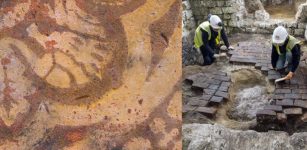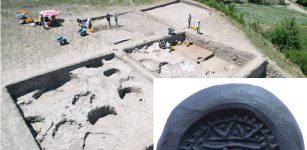Copper: First Metal Used By Ancient Man More Than 10,000 Years Ago
A. Sutherland - AncientPages.com - Copper was used by several ancient civilizations for a number of reasons. It was the first metal ever used by ancient man, dating back more than 10,000 years.
Ancient Egyptians considered copper to be a sacred metal and they believed it gave magical powers to those who wore it.
There is disagreement among archaeologists about the exact date and location of the first utilization of copper by humans.
The Imdugud Relief. Copper alloy relief on bitumen of lion-headed eagle Imdugud gripping the haunches of two stags. Image credit: British Museum
The Sumerians and Chaldeans of Mesopotamia developed considerable skill in fabricating copper and from these centers, the rudiments of craftsmanship spread to the river-dwelling people of Egypt, where it continued to flourish for thousands of years long after their own civilization had degenerated.
Copper comes from the Latin word cuprum, meaning “from the island of Cyprus,” but it is not on this island that we find the most ancient evidence of the use of copper.
The oldest copper artifact ever discovered was unearthed in Tel Tsaf, an archaeological site in Israel located near the Jordan River and Israel's border with Jordan. The area was a village from about 5100 B.C. to 4600 B.C.
A copper awl was discovered at the archaeological site Tel Tsaf in the Jordan Valley of Israel, dating to 5100 B.C. to 4600 B.C. Credit: PLOS ONE, doi: 10.1371/journal.pone.0096882
The cone-shaped copper awl was found in the grave of a woman who was about 40 years old when she died, and who had a belt around her waist made of 1,668 ostrich-egg shell beads.
This ancient copper object provides evidence that metals were exchanged across hundreds of miles in this region more than 6,000 years ago, centuries earlier than previously thought.
Ancient copper plate.
Around 8,000 and 5,000 B.C. the knowledge and use of copper were spread in the regions known now as Turkey, Iran, Iraq, and toward the end of that period we also find traces of copper used on the Indian subcontinent. Archaeologists have also found evidence of mining and annealing of the abundant native copper in the Upper Peninsula of Michigan in the United States dating back to 5,000 B.C.
The Egyptians mined copper from Sinai and used it mostly to produce agricultural tools. Of course, the ancient Egyptians were also rather vain and famously fond of personal beautification. Therefore they manufactured mirrors and razors out of copper and produced green and blue makeup from malachite and azurite, two copper compounds with brilliant green and blue colors.
The ancient Qijia Culture that mysterious disappeared also produced some of the earliest copper mirrors.
Sumerians on the other hand were masters of sculpture and they created some of the most beautiful ancient copper artifacts. As one example, we can mention the magnificent Imdugud Relief which represents a lion-headed eagle holding two stags by their tails.
In time, ancient civilizations understood copper could be used for other means than producing artifacts. The medical use of copper has origins in prehistoric civilizations.
Ancient Egyptians started using copper to sterilize water and wounds around 2,400 B.C, and, by 1,500 B.C., they also used the mineral on burns and itching, and to ease the pain of headaches. In ancient India, copper was used for medical equipment including surgical instruments.
The creation of copper coins came as the next development. Around 3,200 B.C, ancient Egyptian began to utilize copper to create balances and weights used in trade and religious ceremonies. The Assyrians followed up on this idea and used lion weights marked with the names of kings. In ancient China, weights were also made in the shape of animals.
Copper played also a vital role in ancient rituals, ceremonies, and spiritual beliefs. Hathor, the ancient Egyptian goddess of the sky, music, dance, and art, was also the patron of Sinai, the major copper mining region of the Egyptians. She was often referred to as “Lady of Malachite.” In South America, people of the Andes produced a variety of religious items from pounded copper foil and gilded copper.
In many pre-colonial sub-Saharan cultures as well, coppersmiths were believed to have powers as shamans, magicians, and priests because of their intimate knowledge of earth, minerals, and fire and their ability to produce metal from ore. In some parts of the continent coppersmithing was an inherited position with master smiths passing secret knowledge on to their sons. Mining, smelting, and casting of copper ore were preceded by elaborate ceremonies to ensure that the endeavors were safe and fruitful.
So, the history of copper goes far back in time.
Written by – A. Sutherland - AncientPages.com Senior Staff Writer
Copyright © AncientPages.com All rights reserved. This material may not be published, broadcast, rewritten or redistributed in whole or part without the express written permission of AncientPages.com
Expand for referencesMore From Ancient Pages
-
 How Did Ancient People Wake Up On Time Before The Alarm Clock Was Invented?
Ancient History Facts | Mar 29, 2025
How Did Ancient People Wake Up On Time Before The Alarm Clock Was Invented?
Ancient History Facts | Mar 29, 2025 -
 Sir Francis Walsingham: Spymaster, Politician And Trusted Adviser To Queen Elizabeth I
Featured Stories | Nov 25, 2019
Sir Francis Walsingham: Spymaster, Politician And Trusted Adviser To Queen Elizabeth I
Featured Stories | Nov 25, 2019 -
 Hird – Viking Warriors And Professional Body Guards Prepared To Die For Their Leader
Featured Stories | Mar 22, 2018
Hird – Viking Warriors And Professional Body Guards Prepared To Die For Their Leader
Featured Stories | Mar 22, 2018 -
 Mysterious History Of Qin Shi Huang – First Emperor Of China
Featured Stories | Jan 17, 2016
Mysterious History Of Qin Shi Huang – First Emperor Of China
Featured Stories | Jan 17, 2016 -
 10 Types Of Ancient Crosses In Different Cultures Explained
Featured Stories | May 23, 2017
10 Types Of Ancient Crosses In Different Cultures Explained
Featured Stories | May 23, 2017 -
 Evidence Of Beer Drinking 9,000 Years Ago In Southern China Discovered
Archaeology | Sep 1, 2021
Evidence Of Beer Drinking 9,000 Years Ago In Southern China Discovered
Archaeology | Sep 1, 2021 -
 On This Day In History: Execution Of Saints Crispin And Crispinian – On Oct 25, 286
News | Oct 25, 2016
On This Day In History: Execution Of Saints Crispin And Crispinian – On Oct 25, 286
News | Oct 25, 2016 -
 What Is The Codex Sinaiticus And What Does It Mean?
Ancient History Facts | Feb 5, 2019
What Is The Codex Sinaiticus And What Does It Mean?
Ancient History Facts | Feb 5, 2019 -
 Revealing 1,200 Years Of Arctic Canadian Cultures And Settlements In Canada
Archaeology | Jul 11, 2024
Revealing 1,200 Years Of Arctic Canadian Cultures And Settlements In Canada
Archaeology | Jul 11, 2024 -
 Mosaics With Oceanus And Medusa In Tomb Of Ancient City Of Perge, Turkey
Archaeology | May 16, 2017
Mosaics With Oceanus And Medusa In Tomb Of Ancient City Of Perge, Turkey
Archaeology | May 16, 2017 -
 Abundant Hominin Fossils Dating Back 300,000 Years Excavated In Hualongdong (HLD), East China
Evolution | Aug 7, 2023
Abundant Hominin Fossils Dating Back 300,000 Years Excavated In Hualongdong (HLD), East China
Evolution | Aug 7, 2023 -
 23,000-Year-Old Footprints Are Earliest Evidence Of Human Activity Found In The Americas
Archaeology | Sep 23, 2021
23,000-Year-Old Footprints Are Earliest Evidence Of Human Activity Found In The Americas
Archaeology | Sep 23, 2021 -
 Hill Of 100,000 Crosses In Lithuania Survived Against All Odds
Featured Stories | May 23, 2017
Hill Of 100,000 Crosses In Lithuania Survived Against All Odds
Featured Stories | May 23, 2017 -
 Beautiful Ancient Viking Jewelry Made By Skilled Craftsmen
Artifacts | Dec 29, 2015
Beautiful Ancient Viking Jewelry Made By Skilled Craftsmen
Artifacts | Dec 29, 2015 -
 Mysterious Figurine Of Mythical Individual Dates Back To Egypt’s Naqada Culture 4400–3000 BC
Featured Stories | Sep 25, 2016
Mysterious Figurine Of Mythical Individual Dates Back To Egypt’s Naqada Culture 4400–3000 BC
Featured Stories | Sep 25, 2016 -
 Ancient DNA And Tombstones Lead Scientists To Black Death’s Source Strain
Archaeology | Jun 15, 2022
Ancient DNA And Tombstones Lead Scientists To Black Death’s Source Strain
Archaeology | Jun 15, 2022 -
 On This Day In History: Great English Dramatist And Poet William Shakespeare, Was Probably Born – On Apr 23, 1564
News | Apr 23, 2016
On This Day In History: Great English Dramatist And Poet William Shakespeare, Was Probably Born – On Apr 23, 1564
News | Apr 23, 2016 -
 Strange Mythical Creature Resembling A Sphinx Discovered In A Medieval Bathroom
Archaeology | Mar 10, 2020
Strange Mythical Creature Resembling A Sphinx Discovered In A Medieval Bathroom
Archaeology | Mar 10, 2020 -
 3,300-Year-Old Mycenaean-Like Seal And Dagger Discovered In Turkey
Archaeology | Jul 22, 2022
3,300-Year-Old Mycenaean-Like Seal And Dagger Discovered In Turkey
Archaeology | Jul 22, 2022 -
 The Truth About Ancient Rome’s Vomitorium
Featured Stories | Jun 18, 2019
The Truth About Ancient Rome’s Vomitorium
Featured Stories | Jun 18, 2019



